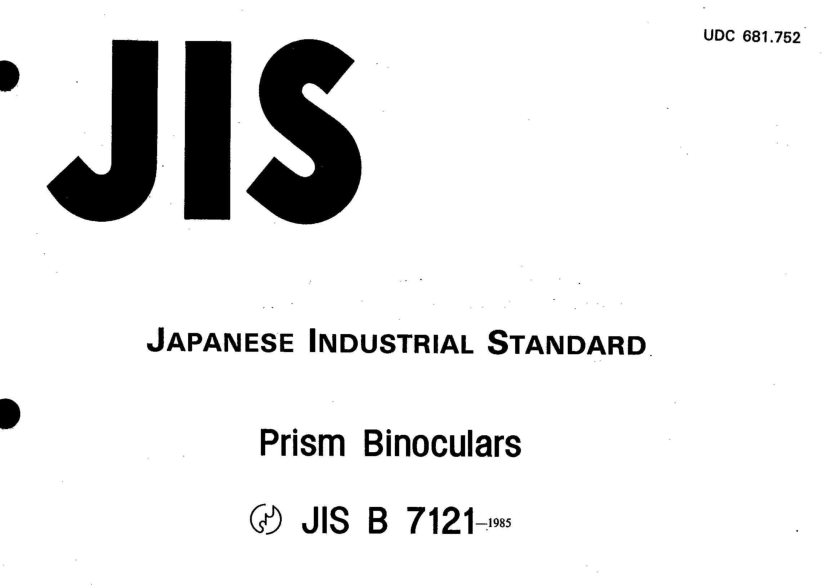JIS B7121:1985 pdfダウンロード

JIS B7121:1985 pdfダウンロード。Prism Binoculars
Scope
This Japanese Industrial Standard specifies the binoculars using prismas erecting optical system, hereinafter referred to as the “binoculars”
Remarks 1.This standard applies also to prism type binoculars usinga plane reflecting mirror instead of prism.
2The units and numerical values given in { } in thisstandard are in accordance with the International Systemof Units (SI),and are appended for reference.
Definitions
For the purposes of this standard, following definitions apply:
variable power type binocularThe binocular capable of changing the magnification.
zoom type binocular The binocular capable of changing con-tinuously the magnification without variation of diopter bymoving a part of optical system along the optical axis.
ocular zoom type binocular The zoom type binocular whichmoves a part of ocular along the optical axis.
real field of view The range of substance space able to beseen through optical system,to be expressed by the angle(degree,minute).
apparent field of view The range of substance space able to be
seen through optical system, to be expressed by the angle(degree,minute)
Remark:The apparent fleld of view shall be the product of realfield of view multiplied by the magnification.
magnificationThe ratio of image size of object (angle) gener-ated by optical system to the size of object viewed by nakedeyes (angle).
Remark:It corresponds to the ratio of apparent field of view toreal fleld of view or the ratio of entrance pupildiameter to exit pupil diameter .
effective diameter of objective lens The diameter of bundle ofrays incident in parallel to the optical axis is objective lens in aobject space. It corresponds to entrance pupil diameter ofoptical system.
Remark:In the case were the binocular optical system is ideal.it becomes the inner diameter of lens frame relative tothe first plane of objective lens.
exit pupil diameterThe diameter (mm) of image of entrancepupil (exit pupil) by optical systemRemark:It corresponds to the value (mm) of effective diameter(mm) of objective lens divided by the magnification.
right and left difference of magnification The difference ofmagnifications of right and left optical systems to be expressedby percentage.
diopterThe degree of convergence or divergence of bundleof rays emitted from ocular to be expressed by dioptory(Dptr).
diopter scale errorThe difference of diopter indicated bydiopter scale marked on the ocular cylinder from the diopter ofbundle of rays emitted from ocular
diopter regulation errorWhen the diopter of optical system isset at 0 Dptr (0 m – by using dioptric tester, the reading ofdiopter indicated by diopter scale marked on ocular cylinder.
right-and-left diopter differenceWhen diopters of right-and-left optical systems are set at 0 Dptr (0 m-I) by using dioptrictester, the difference between the readings of diopter indicatedby diopter scales marked on right and left ocular cylinders.
deviation on diopter of zoom type binocularRunout of dioptergenerated when magnification zoom type binocular is changed. Itis expressed by dioptory (Dptr).
The difference between the position of gradua-reticle parallaxtion lne of reticle and the imagery position of object at infinityby the objective lens, to be expressed by dioptory (Dptr).
ocular width scale errorThe difference of the interval betweencentres of exit pupils of right and left optical systems from theindication value of ocular width scale.
inversion of image The phenomenon or degree where the verti-cal direction of image is inclined relative to the vertical directionof object, when viewing the object through the optical system.It is expressed by angle (degree,minute).
- Previous:JIS B6338:1985 pdfダウンロード
- Next:JIS B8323:1985 pdfダウンロード